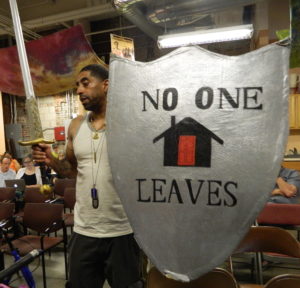This past Tuesday I had the good fortune to attend the weekly meeting of City Life/Vida Urbana , a Boston community organization that advocates for residents on a variety of issues, primarily around housing. Check out this video by Twice Thou that raps City Life’s mission and history.
There are a lot of good reasons to be interested in CL/VU’s activities, but as the Massachusetts Medievalist I wanted to see how they use a sword and shield in the part of their meeting where they welcome new people into their organization. The media has been full recently of medievalist imagery appropriated by neo-Nazis and white nationalists; for a contextual overview, see this part of The Public Medievalist’s great series on “Race, Racism, and the Middle Ages.”
I’ve been searching for a contradictory kind of imagery, an appropriation of the medieval for contemporary progressive causes, perhaps in ways analogous to the early-twentieth-century U.S. suffrage movement’s use of Joan of Arc imagery in their parades (see my 22 May 2017 entry for details on that quest). A Lesley colleague’s involvement with CL/VU tipped me off to their sword and shield.
CL/VU uses a theater-prop plastic sword and a large homemade shield at all of their meetings and many of their protests and rallies around the city. Rather than ancestral heraldry, the shield proclaims that “NO ONE LEAVES” around a simple image of a house.

The sword represents the fight that CL/VU brings to banks and courts and corporations while the shield represents the legal aid they provide to protect their communities from foreclosure and eviction (for more detail, see this news item written at the height of the mortgage crises).
At each weekly meeting, people new to CL/VU come to the front of the room for a ritual that echoes a medieval knighthood ceremony. Tenants and owners in danger of eviction or foreclosure stand close together and all grasp the hilt of the sword. The meeting leader holds the shield; last Tuesday, Twice Thou, whose non-rap name is Antonio Ennis, took this role. He asked them, “Are you willing to fight for your home?” After an initial, somewhat hesitant response, he turned slowly in a circle, showing the shield to all sides of the room. Then he yelled, “Are you willing to fight for your home?” Those gathered in the front of room shouted, “Yes!” and he and all the seated attendants yelled back, “Then we’ll fight with you!” It was exhilarating.

The meeting continued with updates on CL/VU rallies and activities in its networks. A nascent tenants’ association held a separate meeting in the hallway. A staff member handed out slices of pizza to late arrivals. Members met individually in a side room with pro bono attorneys. I hope they get the help they need. My much less necessary quest has been fulfilled – I found a multicultural, multiracial group of working-class Americans consistently using medievalist imagery for their own politically progressive practice, creating solidarity and purpose with the symbolic meanings of sword and shield.
